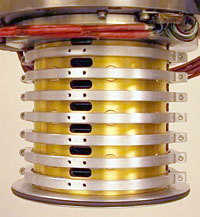Nion is a world-class developer of advanced scanning transmission electron microscopes and other electron-optical instruments. We work in close collaboration with our customers, developing instruments that answer real needs in the real world.
Our microscopes elevate the concept of dedicated STEM (established by Prof. Albert Crewe and initially pursued mainly by VG instruments) to a fundamentally new level. They combine a clean, bakeable vacuum, which minimizes contamination problems; advanced electron optics, which provides unprecedented resolution and makes available many operating modes; and complete flexibility that allows the instruments to be configured for new applications even after they have been installed. They combine user-friendly operation with ease of maintenance. They excel in the resolution obtained at low primary voltages and in the maximum current and the minimum energy spread they deliver into a small probe.
A large part of our resources goes into research aimed at advancing the state of the art in electron microscopy. We design and make state-of-the art aberration correctors, sample stages, detectors, and cold field emission guns. This allows us to ensure that all the components work together seamlessly, and to deliver world-class instruments that function in an integrated and easy-to-use manner.
Nion Company was established in 1997 by Ondrej Krivanek and Niklas Dellby in the state of Washington, USA, with the goal of researching, designing, and manufacturing high-end electron-optical instruments and similar products.
Nion's founders foresaw, in the early 1990's, that practical aberration correction had become technologically feasible, and that it would bring major benefits to electron microscopy and nanoscience in general. Running against the then-prevailing opinion that aberration correction was impossibly complicated, the were very fortunate in securing a grant from the Paul fund of the Royal Society in the UK (for £80k), with the help of Prof. L.M. Brown, FRS and Dr. A.L. Bleloch. The grant plus the wonderful hospitality of the MP group in the Cavendish Laboratory enabled them to design and build their first-generation, proof-of-principle Cs corrector at the University of Cambridge between 1995 and 1997. The close working relationships they established during this time continue with the recent installation of a Nion UltraSTEM™ at the Daresbury SuperSTEM laboratory.

Nion 100 kV / 300 kV Cs corrector for VG STEMs
Nion's first project was designing and building a second-generation spherical aberration corrector for a VG scanning transmission electron microscope. It was a research project initiated by Dr. P.E. Batson and sponsored by the IBM T.J. Watson Research Center. The corrector was a new design that improved on the proof-of principle corrector built in Cambridge in several fundamental ways. It was the first aberration corrector delivered commercially, and the first truly successful STEM corrector. It allowed the VG STEM it was installed in to attain directly interpretable resolution smaller than 1 Å for the first time in electron microscopy. For details, see P.E. Batson, N. Dellby, and O.L. Krivanek (2002) "Sub-ångstrom resolution using aberration corrected electron optics", Nature 418, 617.
The project to design a whole new microscope grew out of the realization that while VG microscopes have many pluses (excellent vacuum, good stability, unsurpassed CFEG performance), they also have many drawbacks (inflexible probe-forming optics, inadequate post-sample optics, lack of sample height control). We were not content to copy the designs established by other microscope manufacturers, but in each case followed our own ideas. The result is an electron microscope of unprecedented qualities and capabilities, such as very flexible illumination optics, high performance detector-coupling optics, and a very advanced 5-axis sample stage.
As of January 2024, Nion is now part of Bruker Corporation. Read the press release here.